2019年12月英语四级翻译练习题库之筷子
- 格式:docx
- 大小:37.67 KB
- 文档页数:2
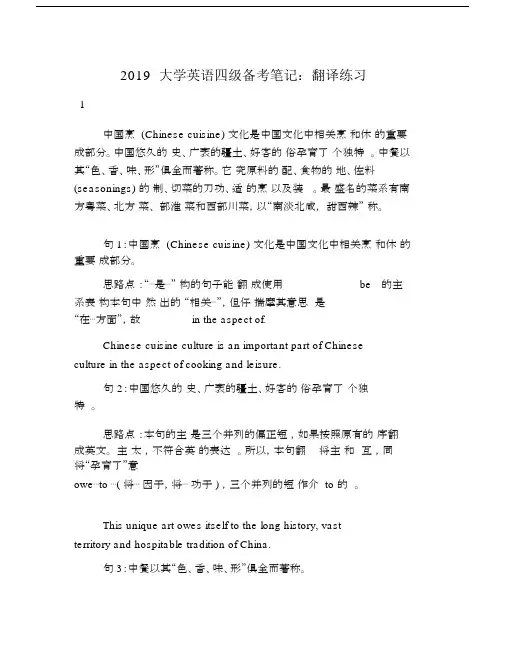
2019 大学英语四级备考笔记:翻译练习1中国烹 (Chinese cuisine) 文化是中国文化中相关烹和休的重要成部分。
中国悠久的史、广袤的疆土、好客的俗孕育了个独特。
中餐以其“色、香、味、形”俱全而著称。
它究原料的配、食物的地、佐料(seasonings) 的制、切菜的刀功、适的烹以及装。
最盛名的菜系有南方粤菜、北方菜、部淮菜和西部川菜,以“南淡北咸,甜西辣” 称。
句 1:中国烹 (Chinese cuisine) 文化是中国文化中相关烹和休的重要成部分。
思路点:“⋯是⋯” 构的句子能翻成使用be 的主系表构本句中然出的“相关⋯”,但仔揣摩其意思是“在⋯方面”,故in the aspect of.Chinese cuisine culture is an important part of Chineseculture in the aspect of cooking and leisure.句2:中国悠久的史、广袤的疆土、好客的俗孕育了个独特。
思路点:本句的主是三个并列的偏正短,如果按照原有的序翻成英文。
主太,不符合英的表达。
所以,本句翻将主和互,同将“孕育了”意owe⋯to ⋯( 将⋯因于,将⋯功于 ) ,三个并列的短作介 to 的。
This unique art owes itself to the long history, vastterritory and hospitable tradition of China.句 3:中餐以其“色、香、味、形”俱全而著称。
思路点:本句中“以⋯而著称”用be famous for来表示;“形”不是“形状”,而是“外”,appearance; “俱全” perfect combination of.Chinese food is famous for its perfect combination of“color, aroma, taste and appearance”.句4:它究原料的配、食物的地、佐料 (seasonings) 的制、切菜的刀功、适的烹以及装。

英语四六级翻译题型大集合-含三中全会筷子、秧歌等21种传统习俗题目(含参考答案)一、三中全会The Third Plenary Session of the CPC 11th Central Committee held at the end of 1978 represented a profound turning point in the history of new China. Since the launch of the Reform and Opening-up Policy, initiated by Deng Xiaoping, in 1979, major efforts have been made to readjust the economic structure, and reform the economic and political systems. China is, step by step, establishing a road with Chinese characteristics, a road that will lead to socialist modernization. Great changes have come about in China since 1979. The situation in the country is the best ever, and the people are enjoying more material benefits than ever before.二、秧歌舞秧歌舞是中国汉族的一种传统民间舞蹈,通常在北方省份表演。
秧歌舞通常穿上明亮多彩的表演服装,他们的表演动作有力而迅速。
在农历春节,元宵节等节日期间,人们一旦听到锣鼓声,不管天气有多冷,他们都会蜂拥到街上观看秧歌舞表演。
近年来,中国东北某些城市的老人自发组织了秧歌队,队员常年通过跳秧歌舞来保持健康,同时他们也乐在其中。
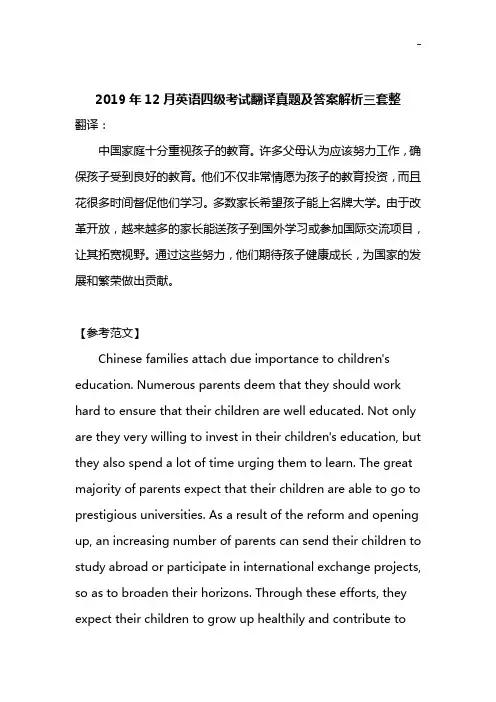
2019年12月英语四级考试翻译真题及答案解析三套整翻译:中国家庭十分重视孩子的教育。
许多父母认为应该努力工作,确保孩子受到良好的教育。
他们不仅非常情愿为孩子的教育投资,而且花很多时间督促他们学习。
多数家长希望孩子能上名牌大学。
由于改革开放,越来越多的家长能送孩子到国外学习或参加国际交流项目,让其拓宽视野。
通过这些努力,他们期待孩子健康成长,为国家的发展和繁荣做出贡献。
【参考范文】Chinese families attach due importance to children's education. Numerous parents deem that they should work hard to ensure that their children are well educated. Not only are they very willing to invest in their children's education, but they also spend a lot of time urging them to learn. The great majority of parents expect that their children are able to go to prestigious universities. As a result of the reform and opening up, an increasing number of parents can send their children to study abroad or participate in international exchange projects, so as to broaden their horizons. Through these efforts, they expect their children to grow up healthily and contribute tothe development and prosperity of the country.【解析】:这一篇翻译的主题是中国家庭教育观念,篇章中主要考察状语以及宾语从句的翻译。

英语四级翻译筷子
筷子起源于中国,大多数是用木头或者竹子制作的。
最早的筷子
是用骨头或者玉(jade)制成的。
在春秋时期(the Spring and
Autumn Period)又出现了铜制和铁制的筷子。
在古代,富裕人家
用玉或金子做筷子,来显示富有。
很多帝王使用银制的筷子检查
饮食是否被投毒。
筷子在传统上还是新娘的嫁妆(dowry),因为
“筷子”的汉语读音听起来很像“快得儿子”。
Chopsticks, which originated in China, are mainly made of wood or bamboo. The earliest chopsticks were made of bone or jade. During the Spring and Autumn Period, copper and iron chopsticks came into being. In ancient times, the rich used jade or gold chopsticks to display their wealth, while many emperors used silver chopsticks to see if their food was poisoned. Chopsticks are traditionally placed in brides’ dowries, too,for the pronunciation of “Chopsticks” in Chinese sounds quite like “get a son soon”.。

2019英语四级传统文化翻译模拟题:筷子筷子原文:筷子(chopsticks)是中国古人发明的一种具有鲜明民族特色的进食工具(tableware),是反映中国饮食文化特色的重要组成部分。
中国人使用筷子的历史可追溯到商代,距今已有三千多年。
筷子可谓是中国国粹,既轻巧又灵活,在世界各国餐具中独树一帜,被西方人誉为“东方的文明”。
凡是使用过筷子的人,不论中国人或是外国人,都因其使用方便、物美价廉而赞叹不绝。
参考译文:The ChopsticksChopsticks, invented by ancient Chinese people, are akind of tableware with distinct national features, being an important component that reflects the characteristics of Chinese diet culture.The history of using chopsticks in China dates back to the Shang Dynasty, more than3,000 yearsago.Chopsticks, the quintessence of Chinese culture, whose lightness and flexibility develop a school of its own among various tableware all over the world, are praised as "Eastern Civilization" by the westerners.All those people who haveever used chopsticks, no matter Chinese or foreigners, marvel at their convenience, excellent quality and reasonable price.。
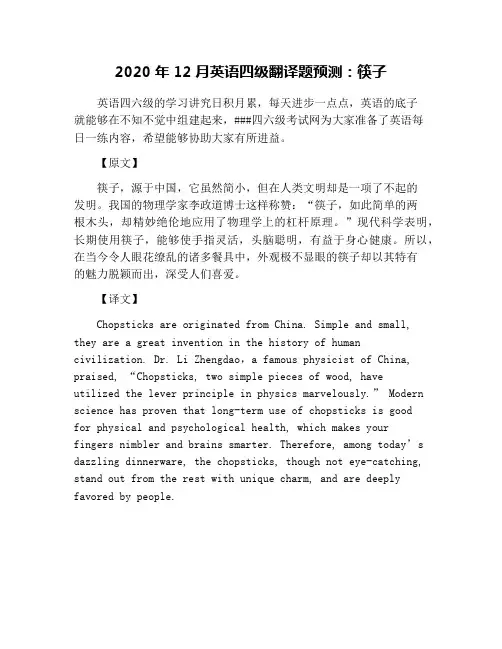
2020年12月英语四级翻译题预测:筷子英语四六级的学习讲究日积月累,每天进步一点点,英语的底子就能够在不知不觉中组建起来,###四六级考试网为大家准备了英语每日一练内容,希望能够协助大家有所进益。
【原文】筷子,源于中国,它虽然简小,但在人类文明却是一项了不起的发明。
我国的物理学家李政道博士这样称赞:“筷子,如此简单的两根木头,却精妙绝伦地应用了物理学上的杠杆原理。
”现代科学表明,长期使用筷子,能够使手指灵活,头脑聪明,有益于身心健康。
所以,在当今令人眼花缭乱的诸多餐具中,外观极不显眼的筷子却以其特有的魅力脱颖而出,深受人们喜爱。
【译文】Chopsticks are originated from China. Simple and small, they are a great invention in the history of humancivilization. Dr. Li Zhengdao,a famous physicist of China, praised, “Chopsticks, two simple pieces of wood, haveutilized the lever principle in physics marvelously.” Modern science has proven that long-term use of chopsticks is goodfor physical and psychological health, which makes yourfingers nimbler and brains smarter. Therefore, among today’s dazzling dinnerware, the chopsticks, though not eye-catching, stand out from the rest with unique charm, and are deeply favored by people.。
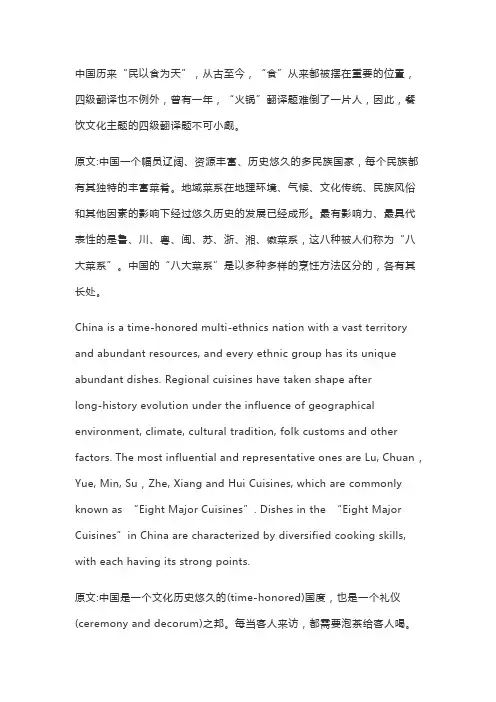
中国历来“民以食为天”,从古至今,“食”从来都被摆在重要的位置,四级翻译也不例外,曾有一年,“火锅”翻译题难倒了一片人,因此,餐饮文化主题的四级翻译题不可小觑。
原文:中国一个幅员辽阔、资源丰富、历史悠久的多民族国家,每个民族都有其独特的丰富菜肴。
地域菜系在地理环境、气候、文化传统、民族风俗和其他因素的影响下经过悠久历史的发展已经成形。
最有影响力、最具代表性的是鲁、川、粤、闽、苏、浙、湘、徽菜系,这八种被人们称为“八大菜系”。
中国的“八大菜系”是以多种多样的烹饪方法区分的,各有其长处。
China is a time-honored multi-ethnics nation with a vast territory and abundant resources, and every ethnic group has its unique abundant dishes. Regional cuisines have taken shape afterlong-history evolution under the influence of geographical environment, climate, cultural tradition, folk customs and other factors. The most influential and representative ones are Lu, Chuan,Yue, Min, Su,Zhe, Xiang and Hui Cuisines, which are commonly known as “Eight Major Cuisines”. Dishes in the “Eight Major Cuisines”in China are characterized by diversified cooking skills, with each having its strong points.原文:中国是一个文化历史悠久的(time-honored)国度,也是一个礼仪(ceremony and decorum)之邦。

筷子英语短文带翻译Using Chopsticks: The Art of Eating in Chinese Culture。
使用筷子,中国文化中的饮食艺术。
Chopsticks, also known as "kuai zi" in Mandarin Chinese, are an essential part of Chinese culture and cuisine.Unlike Western utensils such as knives and forks,chopsticks require a certain level of skill and finesse to use properly. In this article, we will explore the history and art of using chopsticks in Chinese culture.筷子,在中文中也被称为“筷子”,是中国文化和美食中不可或缺的一部分。
与西方的刀叉等餐具不同,筷子需要一定的技巧和精湛的技艺才能正确使用。
在本文中,我们将探讨在中国文化中使用筷子的历史和艺术。
History of Chopsticks。
筷子的历史。
The use of chopsticks dates back over 5,000 years in China. It is believed that chopsticks were first used as cooking utensils, as they allowed people to easily stir and move food around in pots and woks. Over time, chopsticks evolved into eating utensils, and became a symbol of Chinese dining culture.使用筷子的历史可以追溯到中国五千年前。
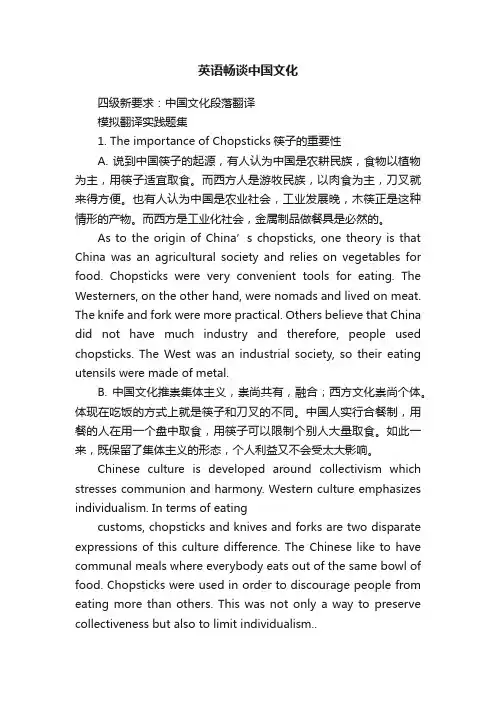
英语畅谈中国文化四级新要求:中国文化段落翻译模拟翻译实践题集1. The importance of Chopsticks筷子的重要性A. 说到中国筷子的起源,有人认为中国是农耕民族,食物以植物为主,用筷子适宜取食。
而西方人是游牧民族,以肉食为主,刀叉就来得方便。
也有人认为中国是农业社会,工业发展晚,木筷正是这种情形的产物。
而西方是工业化社会,金属制品做餐具是必然的。
As to the origin of China’s chopsticks, one theory is that China was an agricultural society and relies on vegetables for food. Chopsticks were very convenient tools for eating. The Westerners, on the other hand, were nomads and lived on meat. The knife and fork were more practical. Others believe that China did not have much industry and therefore, people used chopsticks. The West was an industrial society, so their eating utensils were made of metal.B. 中国文化推崇集体主义,崇尚共有,融合;西方文化崇尚个体。
体现在吃饭的方式上就是筷子和刀叉的不同。
中国人实行合餐制,用餐的人在用一个盘中取食,用筷子可以限制个别人大量取食。
如此一来,既保留了集体主义的形态,个人利益又不会受太大影响。
Chinese culture is developed around collectivism which stresses communion and harmony. Western culture emphasizes individualism. In terms of eatingcustoms, chopsticks and knives and forks are two disparate expressions of this culture difference. The Chinese like to have communal meals where everybody eats out of the same bowl of food. Chopsticks were used in order to discourage people from eating more than others. This was not only a way to preserve collectiveness but also to limit individualism..C. 很多古代用筷的禁忌沿用至今,成为普遍认可的餐桌礼仪。
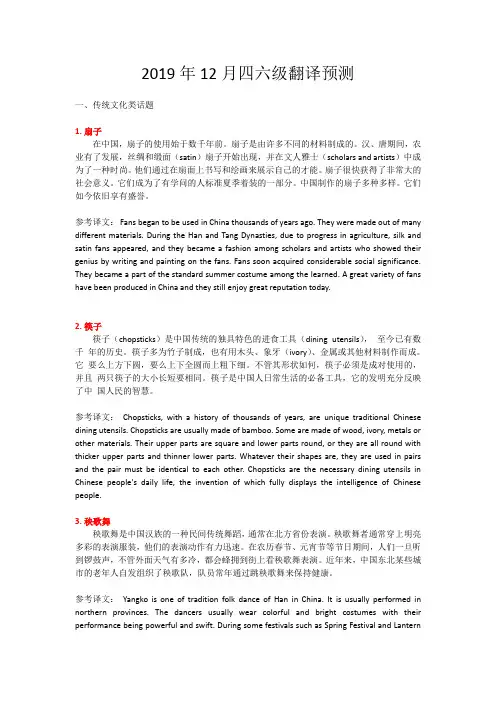
2019年12月四六级翻译预测一、传统文化类话题1.扇子在中国,扇子的使用始于数千年前。
扇子是由许多不同的材料制成的。
汉、唐期间,农业有了发展,丝绸和缎面(satin)扇子开始出现,并在文人雅士(scholars and artists)中成为了一种时尚。
他们通过在扇面上书写和绘画来展示自己的才能。
扇子很快获得了非常大的社会意义。
它们成为了有学问的人标准夏季着装的一部分。
中国制作的扇子多种多样。
它们如今依旧享有盛誉。
参考译文:Fans began to be used in China thousands of years ago. They were made out of many different materials. During the Han and Tang Dynasties, due to progress in agriculture, silk and satin fans appeared, and they became a fashion among scholars and artists who showed their genius by writing and painting on the fans. Fans soon acquired considerable social significance. They became a part of the standard summer costume among the learned. A great variety of fans have been produced in China and they still enjoy great reputation today.2.筷子筷子(chopsticks)是中国传统的独具特色的进食工具(dining utensils),至今已有数千年的历史。
筷子多为竹子制成,也有用木头、象牙(ivory)、金属或其他材料制作而成。
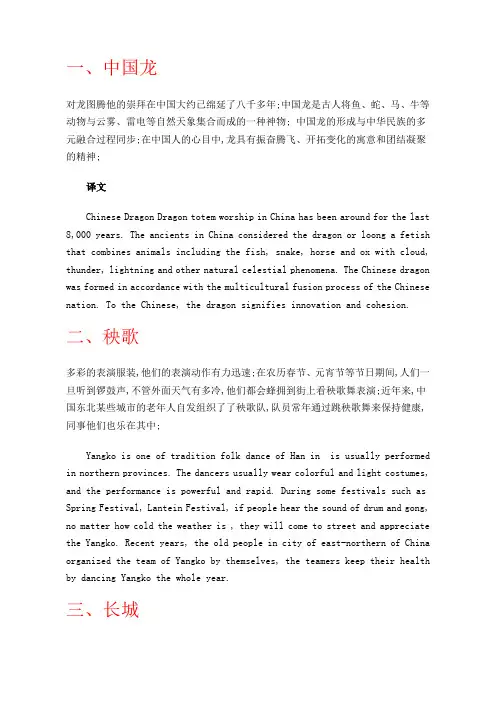
一、中国龙对龙图腾他的崇拜在中国大约已绵延了八千多年;中国龙是古人将鱼、蛇、马、牛等动物与云雾、雷电等自然天象集合而成的一种神物; 中国龙的形成与中华民族的多元融合过程同步;在中国人的心目中,龙具有振奋腾飞、开拓变化的寓意和团结凝聚的精神;译文Chinese Dragon Dragon totem worship in China has been around for the last 8,000 years. The ancients in China considered the dragon or loong a fetish that combines animals including the fish, snake, horse and ox with cloud, thunder, lightning and other natural celestial phenomena. The Chinese dragon was formed in accordance with the multicultural fusion process of the Chinese nation. To the Chinese, the dragon signifies innovation and cohesion.二、秧歌多彩的表演服装,他们的表演动作有力迅速;在农历春节、元宵节等节日期间,人们一旦听到锣鼓声,不管外面天气有多冷,他们都会蜂拥到街上看秧歌舞表演;近年来,中国东北某些城市的老年人自发组织了了秧歌队,队员常年通过跳秧歌舞来保持健康,同事他们也乐在其中;Yangko is one of tradition folk dance of Han in is usually performed in northern provinces. The dancers usually wear colorful and light costumes, and the performance is powerful and rapid. During some festivals such as Spring Festival, Lantein Festival, if people hear the sound of drum and gong, no matter how cold the weather is , they will come to street and appreciate the Yangko. Recent years, the old people in city of east-northern of China organized the team of Yangko by themselves, the teamers keep their health by dancing Yangko the whole year.三、长城长城是人类创造的世界奇迹之一;如果你到了中国却没去过长城,就想到了巴黎没有去看看菲尔铁塔,或者就像到了埃及没有去看金字塔一样;人们常说:“不到长城非好汉;”实际上,长城最初只是一些断断续续的城墙,直到秦朝统一中国后才将其连城长城;然而,今天我们看到的长城——东起山海关,西至嘉峪关——大部分都是在明代修建的;The Great Wall is one of the wonders of the world that created by human beings If you come to China without climbing the Great Wall, it's just like going Paris without visiting the Eiffel Tower; or going to Egypt without visiting the Pyramids Men often say, "He who doest not reach the Great Wall is not a true man."In fact, it began as independent walls for different states when it was first built, and did not become the "Great Wall" until the Qin Dynasty. However, the wall we see today, starting from Shanhaiguan Pass in the east to Jiayunguan Pass in the west, was mostly built during the Ming Dynasty.四、饺子饺子是深受中国人民喜爱的传统食品; 相传为古代医圣张仲景发明;饺子的制作是包括: 1 擀皮、2 备馅、3 包馅水煮三个步骤;其特点是皮薄馅嫩,味道鲜美,形状独特,百食不厌;民间有“好吃不过饺子”的俗语;中国人接亲待客、逢年过节都有包饺子吃的习俗,寓意吉利;对崇尚亲情的中国人来说,“更岁交子”吃饺子,更是欢度除夕、辞旧迎新必不可少的内容;Dumplings Dumplings are one of the Chinese people’s favorite traditional dishes. According to an ancient Chinese legend, dumplings were first made by the medical saint---Zhang Zhongjing. There are three steps involved in making dumplings: 1 make dumpling wrappers out of dumpling flour; 2 prepare the dumpling stuffing; 3 make dumplings and boil them. With thin and elastic dough skin, fresh and tender stuffing, delicious taste, and unique shapes, dumplings are worth eating hundreds of times. There’s an old saying that claims, “Nothing could be more delicious than dumplings”. During the Spring Festival and other holidays, or when treating relatives and friends, Chinese people like to follow the auspicious custom of eating dumplings. To Chinese people who show high reverence for family love, having dumplings at the momentthe old year is replaced by the new is an essential part of bidding farewell to the old and ushering in the new year.五、针灸针灸是中医学的重要组成部分;按照中医的经络理论,针灸疗法主要是通过疏通经络、调和气血,来达到阴阳归于平衡,使脏腑趋于调和之目的;其特点是“内病外治”;主要疗法是用针刺入病人身体的一定穴位,或用艾火的温热刺激烧灼病人的穴位,以达到刺激经络;治疗病痛的目的;针灸以其独特的优势,流传至今并传播到了世界,与中餐、功夫、中药一起被海外誉为中国的“新四大国粹”;Acupuncture is an important part of traditional Chinese medicine TCM. In accordance with the “main and collateral channels” theory in TCM, the purpose of acupuncture is to dredge the channel and regulate qi and blood, so as to keep the body’s yin and yang balanced and achieve reconciliation between the internal organs. It features in traditional Chinese medicine that “internal diseases are to be treated with external therapy”. The main therapy of acupuncture involves using needles to pierce certain acupoints of the patient’s body, or adopting moxibustion to stimulate the patient’s acupoints so as to stimulate the channels and relieve pain. With its unique advantages, acupuncture has been handed down generation after generation and has now spread all over the world. Nowadays, acupuncture, along with Chinese food, kung fu otherwise known as Chinese martial arts, and traditional Chinese medicine, has been internationally hailed as one of the “four new national treasures.”六、七夕节自上世纪90年代后期起,七夕节the Double Seventh Festival 开始被称为“中国的情人节”;这个节日可以追溯到汉朝,当时对恋人、女孩都是个特殊的日子; 这天,女孩会举行仪式,向织女Zhinv乞求智慧、技艺和美满婚姻,所以七夕节还被称为“乞巧节the Begging for SkillsFestival”;如今,一些传统习俗已经弱化;人们现在把七夕节当作浪漫的情人节来庆祝,尤其是在年轻人中间;The Double Seventh Festival has been called Chinese Valentine’s Day since the late 1990s. The festival can be traced back to the Han Dynasty. It was then a special day not only for lovers, but also for would hold a ceremony to beg Zhinv for wisdom, skills and a satisfying marriage. So it is also called “the Begging for Skills Festival”.Today some traditional customs have been weakened. Now the festival is celebrated as a romantic valentine’s day, particularly among young people.七、茶文化原文:中国是一个文化历史悠久的time-honored国度,也是一个礼仪ceremony anddecorum之邦;每当客人来访,都需要泡茶给客人喝;在给客人奉茶之前,你应该问问他们都喜欢喝什么类型的茶,并采用最合适的茶具奉上;奉茶期间,主人需要仔细留意客人的茶杯里的茶量;通常,若是用茶杯泡的茶,在茶喝完一半之后就应该加开水,这样,茶杯就一直都是满的,茶的芳香 bouquet也得以保留;China is a country with a time-honored civilization and also a land of ceremony and guests visit, it is necessary to make and serve tea to serving tea, you may ask them for their preferences as to what kind of tea they fancy, and serve them the tea in the most appropriate the course of serving tea, the host should take careful note of how much water remains in the guests’, if the tea is made in a teacup,boiling water should be added into the cup when half of the tea in it has been consumed; and thus the cup is kept filled and the tea retains the same bouquet.八、八大菜系中国一个幅员辽阔、资源丰富、历史悠久的多民族国家,每个民族都有其独特的丰富菜肴;地域菜系在地理环境、气候、文化传统、民族风俗和其他因素的影响下经过悠久历史的发展已经成形;最有影响力、最具代表性的是鲁、川、粤、闽、苏、浙、湘、徽菜系,这八种被人们称为“八大菜系”;中国的“八大菜系”是以多种多样的烹饪方法区分的,各有其长处;参考译文:Eight Major CuisinesChina is a time-honored multi-ethnics nation with a vast territory and abundant resources, and every ethnic group has its unique abundant dishes. Regional cuisines have taken shape after long-history evolution under the influence of geographical environment, climate, cultural tradition, folk customs and other factors. The most influential and representative ones are Lu, Chuan,Yue, Min, Su,Zhe, Xiang and Hui Cuisines, which are commonly known as “Eight Major Cuisines”. Dishes in the “Eight Major Cuisines”in China are characterized by diversified cooking skills, with each having its strong points.九、筷子原文:筷子chopsticks是中国古人发明的一种具有鲜明民族特色的进食工具tableware,是反映中国饮食文化特色的重要组成部分;中国人使用筷子的历史可追溯到商代,距今已有三千多年;筷子可谓是中国国粹,既轻巧又灵活,在世界各国餐具中独树一帜,被西方人誉为“东方的文明”;凡是使用过筷子的人,不论中国人或是外国人,都因其使用方便、物美价廉而赞叹不绝;参考译文:The ChopsticksChopsticks, invented by ancient Chinese people, are a kind of tableware with distinct national features, being an important component that reflects the characteristics of Chinese diet history of using chopsticks in China dates back to the Shang Dynasty, more than3,000 years , the quintessence of Chinese culture, whose lightness and flexibility develop a school of its own among various tableware all over the world, are praised as "Eastern Civilization" by the those people who have ever used chopsticks, no matter Chinese or foreigners, marvel at their convenience, excellent quality and reasonable price.十、功夫茶功夫茶Gongfu tea不是一种茶叶或茶的名字,而是一种冲泡的手艺;人们叫它功夫茶,足因为这种泡茶方式十分讲究:它的操作过程需要一定的技术,以及泡茶和品茶的知识和技能;功夫茶起源于宋朝,在广东的潮州府今潮汕地区一带最为盛行,后来在全国各地流行;功夫茶以浓度concentration高着称;制作功夫茶主要使用的茶叶足乌龙茶Oolongtea,因为它能满足功夫茶色、香、味的要求;Gongfu tea is not one kind of tea or the name of tea,but a skill of making call it Gongfu tea for the reason of its exquisite process. The operational procedures require certain techniques, knowledge and skill of brewing and tasting tea. Gongfu tea originated in the Song Dynasty and prevailed mostly in Chaozhou Guangdong ProvinceNow: Chaoshan Area. It later became popular around the nation. Gongfu tea is famous for its high concentration. Oolong tea is mainly used in making the Gongfu tea because it can meet the requirements of color, flavor and taste of the Gongfu tea.十一、舞狮舞狮lion dance是一种由一人或两人身披狮型服装lioncostume进行表演的民间表演艺术;据记载,舞狮有两千多年的悠久历史,在唐朝时被引入皇室,成为皇室的娱乐项目;舞狮最注重的是技巧,舞狮者要以夸张的方式模仿狮子的各种表情和动作;经过几千年的发展,舞狮已经在各地形成了不同的表演特色;在中国的传统风俗中,狮子是一种可以去除灾难、带来幸运的吉祥物mascot;因此,每逢节日或隆重的庆典,人们都以舞狮来营造欢乐和热闹的气氛;Lion dance is a folk performing art performed by oneor two persons in lion costumes. According torecords, the dance, with a long history of more than2,000 years, was introduced to the royal family as aform of entertainment during Tang Dynasty. Skill isgiven top priority in performing the lion dance and performers are required to imitate variousexpressions and movements of lions in an exaggerated way. After thousands years ofdevelopment, diverse performing characteristics in different regions have been formed. In thetraditional Chinese custom the lion is regarded as a mascot that wards off misfortunes andbrings good luck. Therefore, during festivals and grand ceremonies, people would perform liondance to create a happy and exciting atmosphere.1.第一句较长,可先提炼其“舞狮是一种民间表演艺术”,译为Lion dance is a folk performing art;“由一人或两人身披狮型服装进行表演的”可译为过去分词短语作定语;2.第二句可将“舞狮在唐朝时被引入皇室,成为皇室的娱乐项目”处理为主句;“有两千多年的悠久历史”可译为with a longhistory of...,作为插入语,放在主语之后;3.第三句“舞狮最注重的是…”包含两短句,使用and连接的并列结构;翻译时可采用被动语态,即skill is giventop priority in...and performers are required to...;4.倒数第二句中“狮子是一种…”,隐含狮子在人们心中的形象,译为is regarded as...比译成is,表达更加地道;十二、神话尽管中国古代神话mythology没有十分完整的情节,神话人物也没有系统的家谱genealogy,但它们却有着鲜明的东方文化特色,其中尤为显着的是它的尚德精神the spirit of esteeming virtue;这种尚德精神在与西方神话特别是希腊神话比较时,显得更加突出;在西方神话尤其是希腊神话中,对神的褒贬标准多以智慧、力量为准则,而中国古代神话对神的褒贬则多以道德为准绳;这种思维方式深植于中国的文化之中;几千年来,这种尚德精神影响着人们对历史人物的品评与现实人物的期望;Although ancient Chinese mythology does not have relatively complete plot and mythological figures don't have systematic genealogy, they have distinct features of oriental culture, among which the spirit of esteeming virtue is particularly compared with Western mythology, especially Greek mythology, this spirit of esteeming virtue is even more Western mythology, especially Greek mythology,the criteria for judging whether a god is good or not are mostly the god's wisdom and strength,while in ancient Chinese mythology, the criterion lies in morality. This way of thinking is deeply rooted in Chinese thousands of years, this spirit of esteeming virtue has affected people's comments on historical figures and expectations of real people.词句点拨1.神话人物:可译为mythological figures;2.系统的家谱:可译为systematic genealogy;其中systematic意为系统的,是system的形容词形式;3.其中尤为显着的是它的尚德精神:将此句译为定语从句among which thespirit of esteeming virtue is particularly significant,承接前一句,可以使译文结构更加紧凑,逻辑更加清晰;十三、度量衡计量,古称度量衡,是实现单位制统一,保证量值准确可靠的活动,是现代国家经济、科技、社会发展的重要基础;计量历史悠久,关系国计民生;公元前221年秦朝建立,秦始皇统一度量衡,成为中国古代统一计量制度的里程碑;1875年5月20日米制公约的签署,开辟了全球范围内推行国际单位制的近代计量新纪元;以量子物理为基础的现代计量科学技术的研究与应用,为人类文明发展提供了更加精准的现代计量技术保障;1999年第21届国际计量大会决定:自2000年起,每年5月20日为“世界计量日”;2015年世界计量日的中国宣传主题与国际主题一致,为“计量与光”;Measurement, which is called metrology in ancient times, is the important foundation of social development of the modern countries’ economy, science and technology. It has a long history and plays an important role in national welfare and the people's livelihood. Established in 221 BC, in the Qin dynasty, Qinshihuang unified weights and measures, and became a unified system for the measurement of milestone in ancient China. On May 20th, 1875, the signing of the convention on metric, opened up a worldwide to implement new era of modern international system of units of measurement. Based on quantum physics, research and application of modern measurement science and technology, provides more accurate modern metrology technical support for the development of human civilization. In 1999, the 21st international conference on measurement made a decision that since 2000, May 20 is for "World Metrology Day". China's propaganda theme of 2015 is in line with international theme for "measurement and light".十四、春节春节是中国人一年中的第一个传统佳节;过去,春节被称为“新年”,因为按照中国一直沿用的农历,这天是正月初一,为新一年的开头;据记载,中国人民过春节已有4000多年的历史,它是由虞舜兴起的;公元前两千多年的一天,舜即天子位,带领着部下人员,祭拜天地;从此,人们就把这一天当作岁首,算是正月初一;据说这就是农历新年的由来,后来叫春节;1911年辛亥革命后,中国采用公历纪年,农历新年便改称“春节”;Spring Festival is the first traditional festival for the Chinese people. In the past years, Spring Festival was called “new year”, for this day was the first day of the lunar month according to the lunar calendar which had long been used in China, so it was the beginning of a new year. It is recorded that Chinese people have celebrated Spring Festival for more than 4000 years, which was started by Yu Shun. One day as far back as 2000 , Shun was inaugurated as the emperor. He led his men to hold a ceremony in honor of Heaven and Earth. From then on, people saw that day as the beginning of the year, . the first day of the lunar month. This is said to be the origin of the lunar new year, which was called Spring Festival later. After the Revolution of 1911, China began to number the years according to the Gregorian calendar, and it was then that the lunar new year began to be called Spring Festival.十五、竹文化中国因其国宝national treasure—熊猫—而闻名于世;熊猫的食物竹子—也深受中国人民的喜爱;中国是世界上拥有竹子最多的国家,被称为竹子的王国;竹文化长久以来深深根植于中国人的思想中;对中国人民来说,竹子是美德的象征;它反映了人的灵魂和情感;中国古代的学者对竹子非常敬重;这就解释了为什么历史上有那么多的着作和绘画都是以竹为主题的;China is worldwide famous for its national treasure, the panda's food, bamboo, is also favored by Chinese is known as the Kingdom of Bamboo possessing more bamboos than any other country in the world. Bamboo culture has been rooted in Chinese people's minds for a long the Chinese people, bamboo is a symbol of virtue, which reflects people's souls and Chinese scholars looked up with great respect to explains why there are so many writings and paintings dedicated to the plant throughout history.1.中国因其国宝—熊猫—而闻名于世:“因...而闻名于世”可译为be worldwide famous for,也可用be worldwideknown for来表示;类似的表达方式还有beknown/famous as作为...而出名,be famous/knownto对...来说很出名;2.中国是世界上拥有竹子最多的国家,被称为竹子的王国:前半句可以理解为“中国有比世界上任何国家都多的竹子”;后半句的“被称为”可译为be known as;“竹子的王国”可译为the Kingdom of Bamboo;3.对中国人民来说,竹子是美德的象征:“象征”可译为symbol, a symbol of意为“某物的象征”;4.中国古代的学者对竹子非常敬重:“中国古代的学者”可译为ancient Chinese scholars;“对...非常敬重”可译为look up with great respect to.", look up to 表示“尊敬”,with great respect表示“满怀敬意”;十六、指南针中国是世界上公认发明指南针的国家;早在2400多年前,中国人就创造出世界上最早的指南针;后来经过不断改进,到宋朝the Song Dynasty人们制造出铁针指南针并应用于航海;中国是第一个在海船上使用指南针的国家;指南针为明代the Ming Dynasty郑和下西洋提供了条件;后来指南针传入欧洲,推动了欧洲航海事业的发展为,哥伦布Columbus的航行提供了技术保证; China is universally recognized as the country having invented the compass. As early as 2,400 years ago, Chinese people created the earliest compass in the world. Later it was further improved continuously. During the Song Dynasty, people produced the compass with iron needles and applied it in navigation. China is the first country using the compass on seagoing ships. The compass provided aid for Zheng He's voyages to the Western Ocean in the Ming Dynasty. Later the compass spread into Europe, promoting the development of the European marine industey and guaranteeing technical support for Columbus' navigation.1.第1句中的“发明指南针的”可处理成后置定语,用现在分词短语having invented the compass来表达,也可用定语从句which has invented...来表达;2.翻译第3句中的“后来经过不断改进”时,宜加上主语“指南针”,而由于前一句的靠后部分已出现过 compass,故这里可用it来作主语;“到宋朝人们制造出铁针指南针并应用于航海”可用并列结构为 people produced... and applied it in...;“铁针指南针”可表达为 compass with iron needles;3.第4句中的“在海船上使用指南针的”较长,宜将其处理成后置定语,用现在分词短语using the compass来表达,其中“在海船上”为状语,译作on sea-going ships,按照英语表达习惯,置于句末;4.最后一句中有3个动作,“指南针传人……,推动了……,……提供了……”,仔细分析可发现,“推动了”和“提供了”是结果,故将“指南针传人……”作句子主干,“推动了……,提供了……”用现在分词短语来表达, 作结果状语,译作 the compass spread into Eurpe, promoting... and guaranteeing...;十七、中华老字号中华老字号China centuries-old/time-honored brands是指那些历史悠久并拥有良好信誉的中国企业;这些企业往往具有鲜明的中华民族传统文化特征,拥有高品质的产品、技艺或服务,取得广泛的社会认同;同仁堂Tongrentang和全聚德Quanjude 均属北京的老字号;同仁堂创建于1669年,其药品以优良的传统工艺和显着的疗效享誉海内外;以北京烤鸭闻名的全聚德创建于1864年,是中国着名的饭店;参考译文:China time-honored brands refer to the Chinesecompanies which have 汪long history as well as agood reputation. With distinct characteristics oftraditional Chinese culture, they get extensivepublic recognition by offering good-qualityproducts, techniques or services. Both Tongrentangand Quanjude are the time-honored brands in Beijing. Tongrentang was founded in 1669,andits medical products have enjoyed a good reputation both at home and abroad for excellenttraditional manufacturing techniques and good effects. Founded in 1864 and well-known for itsBeying roast ducks, Quanjude is a famous restaurant in China.1.第1句中的定语“历史悠久并拥有良好信誉的”较长,故将其处理成定语从句Which have a long history as well as agood reputation,也可用介词短语 with a long historyand a good reputation 来表达;2.第2句“这些企业往往具有......,拥有......,取得......”有3个动词,仔细分析可发现,第1个动词短语表状态,第2个为方式,第3个为结果,故翻译时将第3个分句处理成主干,第1个为伴随状语,第2个为方式状语,这样既可以使句子各成分之间的逻辑关系更清晰,也更符合英文的表达习惯;3.倒数第2句“同仁堂创建于1669年,其药品......”可用并列结构译出:Tongrentang was founded in1669, and its medical products...;“以优良的传统工艺和显着的疗效”用介词短语for excellenttraditional manufacturing techniques and good effects 来表达;4.在最后一句中,将“是中国着名的饭店”处理成主干:Quanjude is a famous restaurant in China;将“以北京烤鸭闻名的全聚德创建于1864年”处理成两个并列的状语,“创建于1864年的”和“以北京烤鸭闻名的”, 按照时间逻辑关系,用分词短语译出 Founded in 1864 and well-known for its Beijing roast ducks;。
2019四级翻译新题型模拟练习及答案:筷子
说到筷子(chopsticks)的起源,中国是世界上第一个使用筷子的国家,用筷子吃饭已经有至少3000年的历史了。
筷子看起来很简单,只有两根小细棒,但它有很多功能,比如挑选,移动,夹,搅拌或者挖。
此外,它便于使用,价格便宜。
而且筷子也是世界上独有的餐具(tableware)。
使用複子的人,无论是中国人还是外国人,都无不钦佩筷子的发明者。
参考译文
As the origin of chopsticks, China is the first country in the world to use chopsticks and has a history of at least 3,000 years to have meals with chopsticks. Chopsticks seems quite simple with only two small and thin sticks, but it is in possession of many functions, such as picking, moving, nipping, mixing and digging; moreover,it is convenient for use and cheap in price. Besides, chopsticks are also unique tableware in the world. Anyone using chopsticks,no matter Chinese or foreigners, would without exception admire the inventor of chopsticks.。
2019大学英语四级翻译真题练习:筷子翻译题目中国人每天都在使用筷子(chopsticks),这在很多外酬友眼里似乎是一个奇迹。
历史记载表明筷子的使用已有3000年的历史。
在古代,富人用金子制成筷子以显示其富有。
筷子还有其他功能,比如过去人们用银制的筷子检查他们的食物是否被人投了毒。
现在,很多外国朋友在访问中国的时候都使用筷子。
据说,尼克松(Nixon)总统到中国访问时,在欢迎宴会上也使用了筷子。
表达难点1.第1句后半句的“这”指代前半句的内容,故后半句可处理成which引导的非限制性定语从句。
2.第2句中的“筷子的使用已有3000年的历史”可译为the use of chopsticks has a history of years.不过前面的“历史记载”译为historical record,英语的表达习惯忌讳重复用词,而historical是history 的派生词,故换种说法,译为dates back to three thousand yeare age.3.第3句中的“以显所其富有”可用不定式短语to displaytheir wealth表达,作目的状语,比they were rich表达更简洁些。
4.最后一句的主要结构为“尼克松总统也使用了筷子”,时间状语“到中国访问时”和地点状语“在欢迎宴会上”后置。
而在英语的表达习惯中,时间状语常位于地点状语后,故译为at the welcoming banquet when he visited China.参考译文Chinese people use chopsticks every day, which seems a wonder to many foreigners. Histcaical records show that the use of chopsticks dates back to three thousand years ago. Inancient times, the rich used gold chopsticks to display their wealth. Chopsticks have many other functions as welL.In the past, for example, people used silver chopsticks to see if their food was poisoned.Nowadays many foreign friends try to use chopsticks when they visit China. It's said that President Nixon also used chopsticks at the welcoming banquet when he visited China.。
2019年12月四级翻译练习及解析:筷子历史请将下面这段话翻译成英文:筷子(chopsticks)是中国古人发明的一种具有鲜明民族特色的进食工具(tableware),是反映中国饮食文化特色的重要组成部分。
中国人使用筷子的历史可追溯到商代,距今已有三千多年。
筷子可谓是中国国粹,既轻巧又灵活,在世界各国餐具中独树一帜,被西方人誉为“东方的文明”。
凡是使用过筷子的人,不论中国人或是外国人,都因其使用方便、物美价廉而赞叹不绝。
参考译文:Chopsticks, invented by ancient Chinese people, are a kind of tableware with distinct national features, being an important component that reflects the characteristics of Chinese diet culture. The history of using chopsticks in China dates back to the Shang Dynasty, more than3,000 years ago. Chopsticks, the quintessence of Chinese culture, whose lightness and flexibility develop a school of its own among various tableware all over the world, are praised as "Eastern Civilization" by the westerners. All those people who have ever used chopsticks, no matter Chinese or foreigners, marvel at their convenience, excellent quality and reasonable price.。
筷子是最能反映中国饮食文化特色和传统的重要象征之一。
筷子有着悠久的历史,有关筷子的记载可以追溯到3000多年以前。
无论到何时何地,中国人吃饭都很难离开筷子。
从此,筷子还可以作为礼仪(etiquette)、馈赠、寄情、收藏的特殊工艺品和礼品。
如今,筷子已经出现在全世界很多国家的餐桌上,西方还流行起了“为了您的健康,请您拿起筷子来”的时潮。
Chopsticks are one of the important symbols that can most reflect the characteristics and traditions of Chinese food culture. Chopsticks have a long history and the records of them can be traced back to more than 3000 years ago. Wherever and wherever, it is hard for Chinese people to have meals without chopsticks. In addition, Chopsticks can also be used as special handicrafts and presents for etiquette, gifting, expressing feelings and collection. Today, Chopsticks have appeared on the table of many countries all over the world and there is even a fashion of “please pick up Chopsticks for your fitness” prevalent in the western countries.京剧(Beijing Opera)是中国的国粹。
2019 年 12 月四六级翻译预测一、传统文化类话题1.扇子在中国,扇子的使用始于数千年前。
扇子是由许多不同的材料制成的。
汉、唐期间,农业有了发展,丝绸和缎面( satin)扇子开始出现,并在文人雅士( scholars and artists )中成为了一种时尚。
他们通过在扇面上书写和绘画来展示自己的才能。
扇子很快获得了非常大的社会意义。
它们成为了有学问的人标准夏季着装的一部分。
中国制作的扇子多种多样。
它们如今依旧享有盛誉。
参考译文: Fans began to be used in China thousands of years ago. They were made out of many different materials. During the Han and Tang Dynasties, due to progress in agriculture, silk and satin fans appeared, and they became a fashion among scholars and artists who showed their genius by writing and painting on the fans. Fans soon acquired considerable social significance. They became a part of the standard summer costume among the learned. A great variety of fans have been produced in China and they still enjoy great reputation today.2.筷子筷子( chopsticks )是中国传统的独具特色的进食工具( dining utensils ),至今已有数千年的历史。
2019年12月卷一:中国的家庭观念与其文化传统有关。
和睦的大家庭曾非常令人羡慕。
过去四代同堂并不少见。
由于这个传统,许多年轻人婚后继续与父母同住。
今天,这个传统正在改变。
随着住房条件的改善,越来越多年轻夫妇选择与父母分开住。
但他们之间的联系依然很密切。
许多老年人仍然帮着照看孙辈。
年轻夫妇也抽时间探望父母,特别是在春节和中秋等重要节日。
China's family concept is related to its cultural tradition. The harmonious family used to be enviable. It's not uncommon for the past four generations to live together. Because of this tradition, many young people continue to live with their parents after marriage. Today, the tradition is changing. With the improvement of housing conditions, more and more young couples choose to live separately from their parents. But they are still very close. Many old people still help look after their grandchildren. Young couples also take time to visit their parents, especially on important festivals such as the Spring Festival and the Mid Autumn Festival.2019年12月试卷二:中国家庭十分重视孩子的教育。
2019年12月英语四级翻译练习题库之筷子
请将下面这段话翻译成英文:
筷子
筷子(chopsticks )是中国古人发明的一种具有鲜明民族特色的进
食工具(tableware),是反映中国饮食文化特色的重要组成部分。
中国
人使用筷子的历史可追溯到商代,距今已有三千多年。
筷子可谓是中
国国粹,既轻巧又灵活,在世界各国餐具中独树一帜,被西方人誉为“东方的文明”。
凡是使用过筷子的人,不论中国人或是外国人,都
因其使用方便、物美价廉而赞叹不绝。
参考翻译:
The Chopsticks
Chopsticks, invented by ancient Chinese people, area kind of tableware with distinct national features,being an
important component that reflects thecharacteristics of Chinese diet culture. The historyof using chopsticks in China dates back to the Shang Dynasty, more than 3,000 years
ago.Chopsticks, the quintessence of Chinese culture, whose lightness and flexibility develop aschool of its own among various tableware all over the world, are praised as “EasternCivilization” by the westerners. All those peo ple who have ever used chopsticks, no matterChinese or foreigners, marvel at their convenience, excellent quality and reasonable price.
1.追溯到:应译为date back to...要注意在使用这个短语时,通常使用一般现在时,并且要用主动语态,而非被动语态。
2.中国国粹:应译为the quintessence of Chineseculture。
“国粹”,即某一国家文化的精髓,所以使用quintessence—词表达最为恰当。
3.轻巧又灵活:“轻巧”指的是筷子本身重量较轻,便于使用,所以用lightness来表达;“灵活”翻译为flexibility。
在翻译此类短语时要注意根据语境把握词语的准确含义,进而寻找最恰当的词语来表达。
4.独树一帜:可译为develop a school of its own, “发展一个属于自己的流派”,就是“独树一帜”,这种非常地道的表达方式应该注意多积累。
5.物美价廉:该词能够有很多种翻译方式,可译为excellent quality and reasonable price,或者简单地译为 cheap and fine。